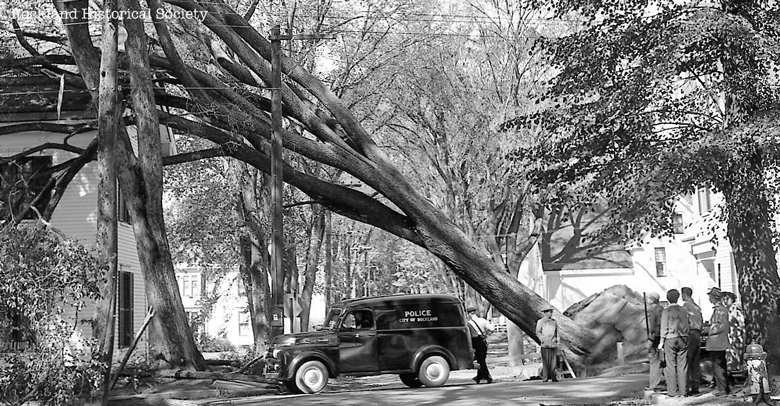The photo we ran on page 9 in the February/March issue showed a large tree with its roots torn from the ground, leaning onto wires and another tree (and possibly a house) with a Rockland police vehicle parked nearby. We asked readers from more information, and as usual, they came through with the goods.
Fred Stoddard writes that the tree was “on the northwest corner of Talbot Avenue and Union Street” and came down in Hurricane Edna. “I grew up in that neighborhood. The apartment building on the left received little damage. My grandmother lived in the other end, her first name was Edna. And yes, they did have gasoline-powered chainsaws.”
Rob Lindsay noted our caption speculated about the photo being from the late 1940s or early 1950s. “Could it have been a result of Hurricane Carol in 1953, or even the Great Atlantic Hurricane in 1944? There was lots of damage along the whole coast in those storms.”
Duncan LaBay of Spruce Head must have used a magnifying glass to get to the truth:
“The picture contains two clues,” he writes, “leaves on the trees and a 1951-53 Dodge police truck. That immediately suggested to me that it was very likely taken following one of the late-summer hurricanes in 1954.”
LaBay notes that he was “just shy of three-years-old when hurricanes Carol and Edna came through Portland, and I remember our being without electricity and my mother cooking on an old wood stove in the cellar. The neighbors lost several very large trees in the storms.”
The Rockland Historical Society, he says, tied the image to September 1954 following Hurricane Edna.
And marine scientist Bob Steneck keyed on the species of tree:
“Perhaps everyone knows this but that looks to me to be an elm. The branches from the middle to the left (lower) look to have the bend of an elm. The loss of mighty elms is one of the saddest changes that has occurred in Maine (and elsewhere). Isn’t Elm Street right around the corner from the Island Institute?
“I’ve seen old photos of the street back in the day. Your photo illustrates well how grand those old elms where. I think the disease was introduced to North America around 1920 so might that have been an already dead or dying elm.”
Thank you, readers!
—Tom Groening





